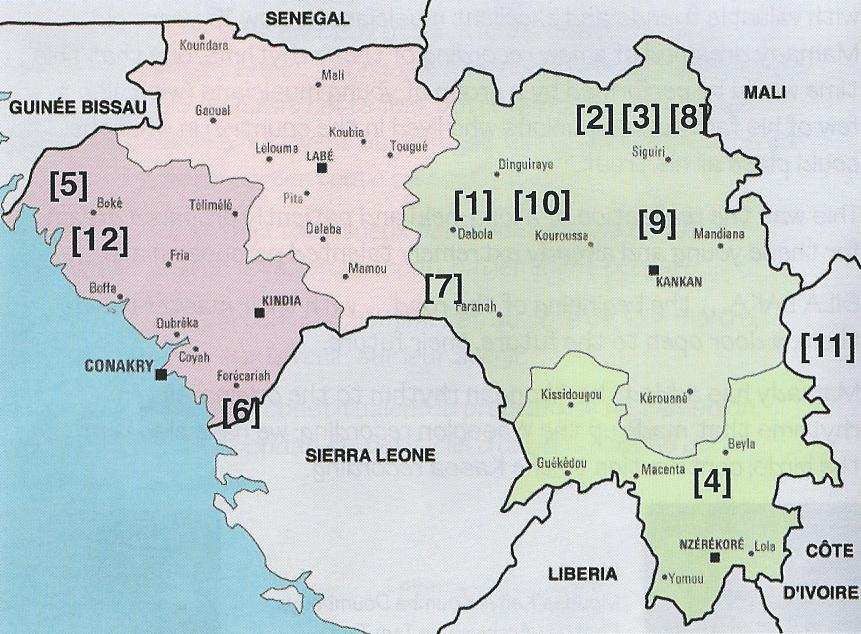jole
Keita, Mamady. 1989. Wassolon. Fonti Musicali, FMD 581159.
(Djole)
Rythme traditionnel Temné, très populaire à Conakry. Les Temnés vivent en Sierra Leone près de la frontière guinéenne. Djole est une danse de masque jouée d’ordinaire sur des tambours à cadre carré que l'on nomme sico. Mamady en propose sa version adaptée pour le djembe. Il improvise en malinke et en susu un chant comportant aussi de nombreuses onomatopées dont le rôle est ornemental.
Diabate, Karamba. 1996? Journey Into Rhythm: The Rhythms & Music of Guinea West Africa. 2 vols. Third Ear Productions.
(Djolè)
Djolè is a rhythm originating from the country of Sierra Leone and originally played on the siko, a drum consisting of a goat skin mounted on a wooded frame, played with a hand or stick. The rhythm was adapted by the coastal people of Guinea. It has become a very popular celebration rhythm often played rejoicing under the full moon.*
* Transcription mine.
Billmeier, Uschi. 1999. Mamady Keita: A Life For the Djembe—Traditional Rhythms of the Malinke. Engerda, Germany: Arun-Verlag.
(Djole, or Jole)
Traditional Ethnic Group: Temine; Border Region Guinea/Sierra Leone
Djole is a very well known rhythm that owes its popularity to some Mandenyis who brought it to Conakry. Now, it is played all over West Africa. In the beginning, it was a mask dance representing a woman. The mask was worn by a man who dressed as a woman.
Djole always was a great village festivity, where several villages got together in order to celebrate a big harvest, the end of Ramadan, or a wedding.
The original instrument for this dance was the siko, four square drums of different sizes that were played together. Today, the rhythm is also played with djembé and dunun.
Forè Foté. 1999. Wonberé: Music and Dance in Black and White.
(Yolé)
Traditional mask dance from the Temne ethnic group located in Sierra Leone, near the Guinée border. Yolé was originally played on sico, a square shaped drum with goat skin stretched over one side, but can be heard popularly in Conakry at nearly all festive occasions, played on sico and /or Yembé.
Keita, Mamady. 2004. Guinée: Les rythmes du Mandeng. Vol. 1. Fonti Musicali, FMU 0310.
(Djolé)
Djolé is a rhythm from the Mandeni and Temne people. It comes from the border region of the Southwest where Guinea meets Sierra Leone. It is a mask dance. The dancer wears a mask which represents women. Djolé has become very popular all around Guinea and is danced at all the big celebrations, such as: end of Ramadan, the time of the great harvest, marriages, etc.*
* Transcription mine; of English-language DVD narration.
Keita, Mamady. 2004. Sila Laka. Fonti Musicali, FMD 228.
(Djolé)

Djolé: Laïlaïko Korobé. Temné. Region: Guinée - Sierra Leone (no. 6 on map)
Joué à l'origine pour un masque représentant une femme et dansé par un homme portant des vêtements féminins.
Dans le texte chanté, on entend le terme siko qui désigne le tambour à cadre carré sur lequel le rythme était joué autrefois.
Devenu très populaire à Conakry et dans toute l'Afrique occidentale, Djolé est joué à l'occasion des grandes fêtes pour la fin du Ramadan, pour conclure le travail des grandes récoltes, et aussi pour les mariages.
Les chanteuses utilisent un mélange de langues dont le soussou et le malinke ainsi que de nombreuses onomatopées, rendant le chant pratiquement intraduisible.
Laïlaïko
Korobé, korobé, korobé
Mamiwatölé
Aïya
Sikoleleléko
Aïya
Sikolaïko, sikolaïko
Wawanko, sikolaïko
Bangoura, Fode Seydou. 2005. Fakoly 1.
(Djolé)
Djolé is a Temne rhythm, which is very popular in Conakry. It invokes the spirit of a woman's mask and is traditionally played on square "Sico" drums. The Temne live across the border in Sierra Leone.
Diaby, Mohamed. 2007. Ala Na Na. Mohamed Diaby.
(Djolé)
A native feminen [sic] mask dance of the Timanee [sic] people from Sierra Leon [sic].
Delbanco, Åge. 2012. West African Rhythms. Charleston, SC: Seven Hawk.
(Djolé)
From Sierra Leone; originally played on rectangular frame drums.